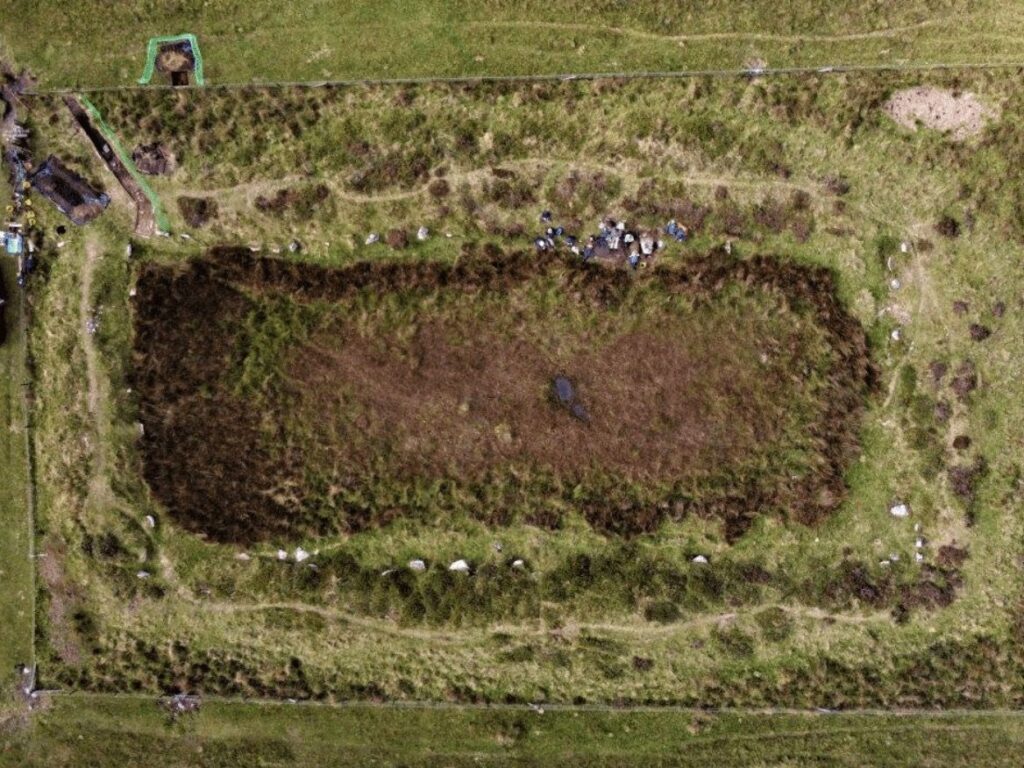King Arthur’s Hall in Cornwall was named for the legendary leader of the Round Table.
Historic England
In the Cornish moorlands of southwest England lies a mysterious mound of stone and turf. Now covered with grass, the site was previously thought to be a medieval livestock pen built around 1000 C.E. Now, researchers have concluded the construction is actually 4,000 years older—dating to at least 3000 B.C.E., during the Neolithic period.
Known as King Arthur’s Hall, the unique site is located in Bodmin Moor in Cornwall. It’s about 160 feet long and 70 feet wide, and its walls are made of 56 earth-covered stones, which once stood upright. Now, they are all leaning, lying flat or buried.
“There isn’t another one of these anywhere,” James Gossip, lead archaeologist of the Cornwall Archaeological Unit, tells the Guardian’s Esther Addley. “There is nothing built at that time or subsequently in prehistory that is a rectangular earth and stone bank with a setting of stone orthostats around the interior. There is no … parallel.”
Volunteers and experts excavated the site in September 2022.
Cornwall National Landscape
The saga began a few years ago, when local archaeologists started questioning King Arthur’s Hall’s medieval origins. In response, Cornwall National Landscape, which protects local lands, commissioned an investigation to learn more.
Soon after, researchers from the Cornwall Archaeological Unit and specialists from several universities got to work. They dug a small trench near the entrance to the site, taking samples for radiocarbon dating. The team also used a technique called optically stimulated luminescence, which helps scientists determine when sediment was last exposed to light, according to a statement from Cornwall National Landscape.
“We were able to demonstrate that the buried soil beneath the bank was disturbed at construction—resetting the luminescence signals and providing the opportunity to date the monument,” says Tim Kinnaird, a geologist at the University of St. Andrews, in a statement from the university. “It’s extremely exciting that we’ve finally been able to date construction of this enigmatic monument, previously grounded in myths and legends.”
Fifty-six stones support the monuments walls.
Cornwall National Landscape
As the monument’s name makes clear, it’s traditionally connected to the legend of King Arthur, the storied leader of the Round Table featured in medieval literature. While historians have little evidence that King Arthur was a real person, his life is generally associated with the fifth and sixth centuries C.E., long after the mysterious structure was built.
“The Middle Ages was a period when the Arthur name started being attributed to all sorts of unusual sites that the local population at the time probably didn’t understand,” Gossip tells the Guardian. “That suggests its original function had been lost by that point, but people attributed it to King Arthur because he had this association with something mythical and powerful.”
During the Neolithic period, the era in which King Arthur’s Hall was actually built, populations in Britain were beginning to settle down, shifting toward building and farming rather than hunting and gathering. Britain’s Neolithic period lasted from around 4300 B.C.E. to 2000 B.C.E., and some of its famous monuments include the stone circles of Avebury and Stonehenge.
In light of King Arthur’s Hall’s newly determined age, researchers must now think about it in the context of the region’s prehistoric landscape, as Kinnaird says in St. Andrews’ statement. However, the purpose of King Arthur’s Hall is still a mystery.
Many Neolithic monuments were “meeting points for communities, perhaps to mark special occasions or to carry out ceremonies,” Gossip tells the Guardian. He theorizes that King Arthur’s Hall had a similar function, though “it remains as an enigma.”
Kinnaird tells Live Science’s Tom Metcalfe that Bodmin Moor is home to several other prehistoric monuments, including standing stones and burial mounds, suggesting extensive Neolithic activity in the region.


